Key takeaways:
- Dental anxiety is common and can stem from various triggers, making it essential for patients to communicate their specific fears to their dentists.
- Effective communication and preparation, such as bringing questions to appointments or familiarizing oneself with the clinic, can significantly reduce anxiety.
- Relaxation techniques, like deep breathing and visualization, can help patients manage nerves before and during dental visits.
- Understanding what to expect during procedures, including explanations of sounds and steps, can transform anxiety into a sense of control and participation.
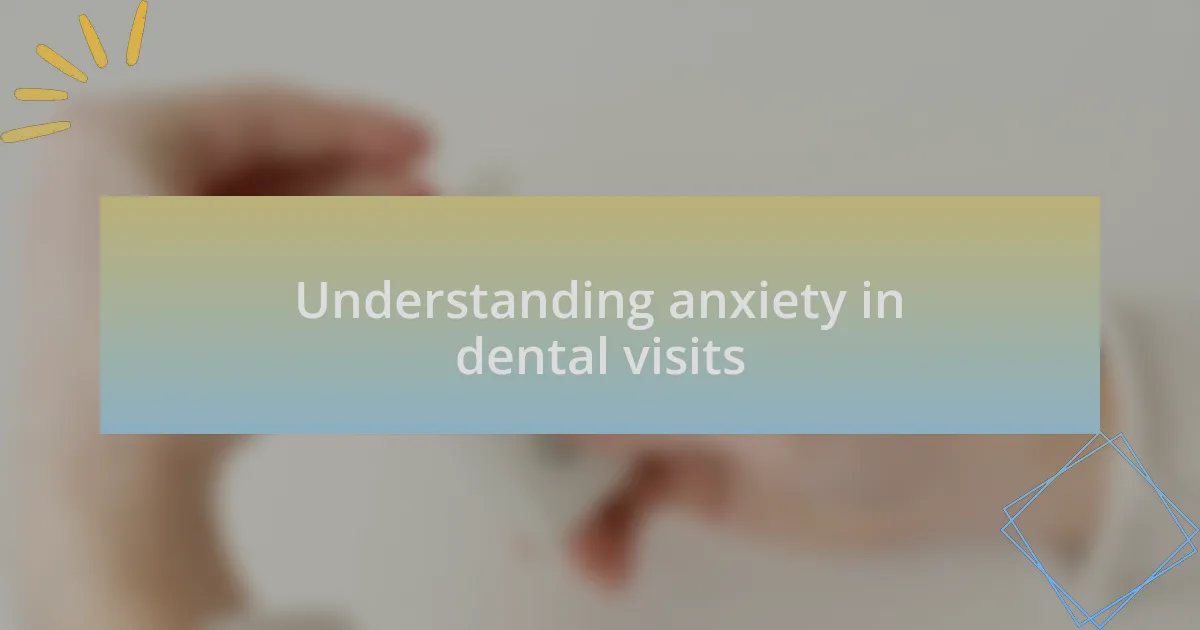
Understanding anxiety in dental visits
Anxiety related to dental visits is more common than many might imagine. I remember the first time I stepped into a dental clinic. The sterile smell and bright lights were enough to send my heart racing. It’s not just about the dental chair; it’s the unknown of what might happen during an appointment that can trigger a wave of fear.
Have you ever felt a knot in your stomach while waiting to be called back? This anticipation often magnifies our worries, transforming minor concerns into overwhelming dread. I find that understanding the root of this anxiety can be incredibly empowering. It helps patients recognize that they’re not alone in feeling this way, creating a sense of camaraderie in the often-isolating experience of dental care.
Moreover, it’s crucial to acknowledge that anxiety can manifest differently for each person. For some, it’s the sound of the drill that sends shivers down their spine, while for others, it’s the fear of pain or not being in control. I often encourage patients to share their specific triggers with their dentist. This openness can lead to tailored approaches, making the dental experience far less daunting.
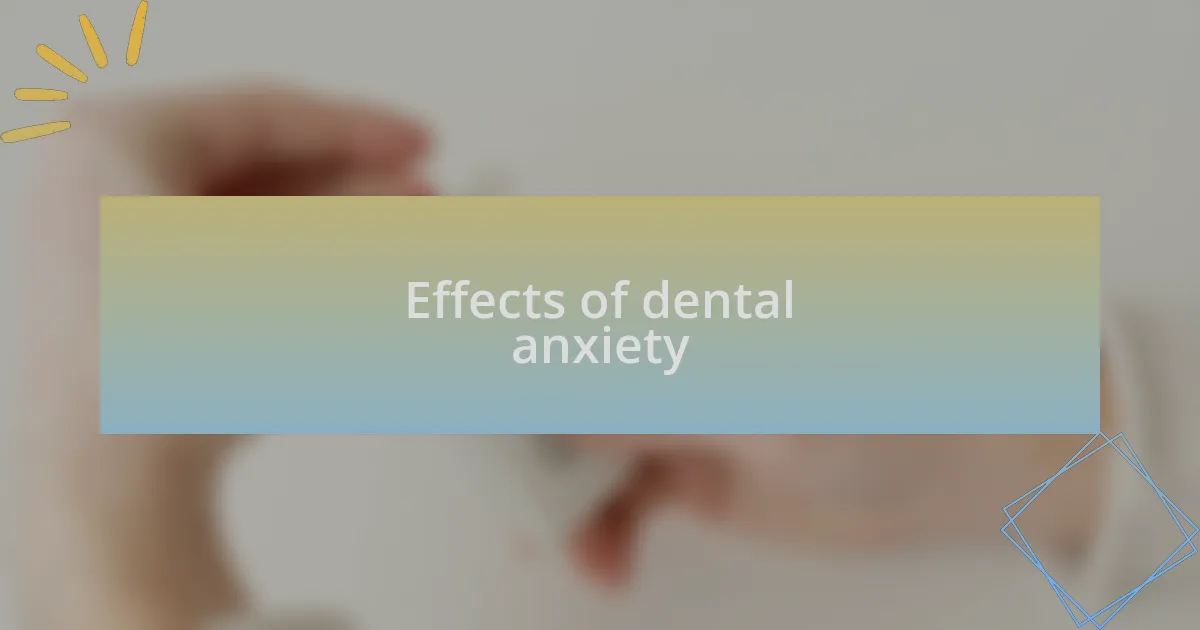
Effects of dental anxiety
Dental anxiety can lead to a variety of negative effects that extend beyond just the dental chair. Personally, I’ve seen patients who skip appointments due to fear, resulting in untreated dental issues that only worsen over time. It’s disheartening to realize that their anxiety can create a vicious cycle; the longer they wait, the more the dread builds, making it even harder to seek care.
Engaging with anxious patients often reveals the physical toll anxiety can take, such as increased heart rate, sweating, or even nausea. I recall a patient who shared that just sitting in the waiting room made them feel dizzy. It’s fascinating to think about how emotional stress can manifest physically, impacting not only their dental health but also their overall well-being.
This anxiety doesn’t just affect the individual; it can ripple out, influencing relationships and daily life. Friends and family may notice when a loved one struggles to keep dental appointments due to fear. It prompts me to ask: how might better communication about these anxieties improve not only the dental experience but also personal connections? In my experience, when patients feel empowered to share their feelings, it opens doors to a more supportive environment.
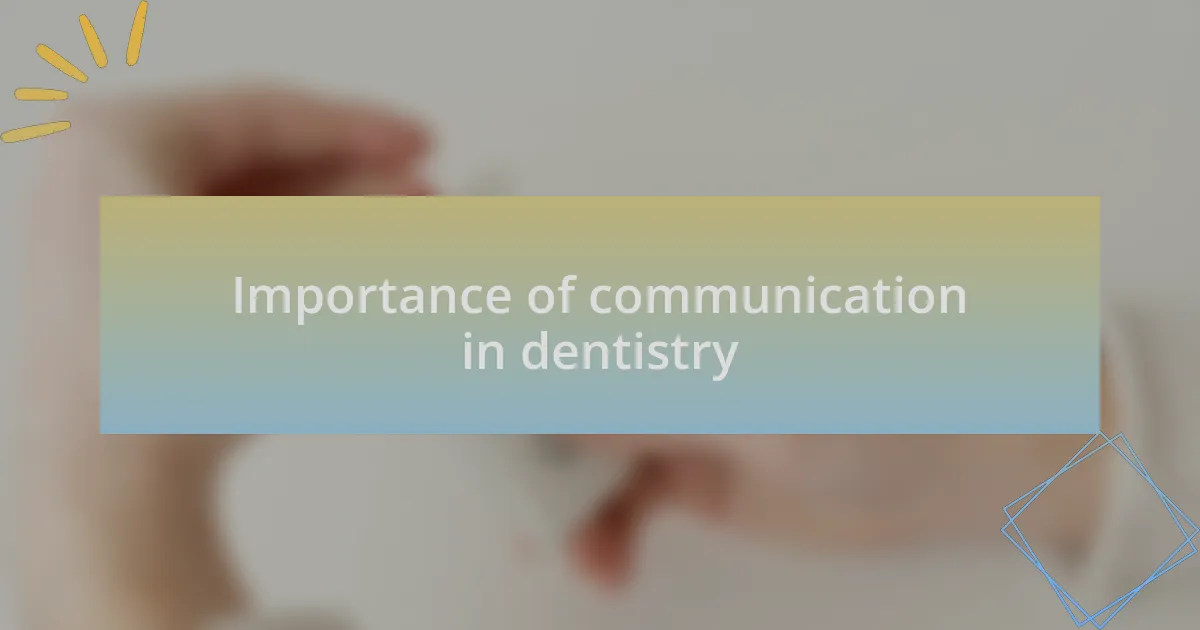
Importance of communication in dentistry
Effective communication in dentistry is crucial for alleviating fears and building trust. I remember a time when a patient expressed their concern about the sounds of the dental tools. By simply explaining each instrument and its purpose, I saw their hands unclench and their breathing ease. It’s often the unknown that heightens anxiety, and taking that time to communicate can drastically change a patient’s experience.
Moreover, proactive communication helps in tailoring dental care to the specific needs of anxious individuals. For instance, a patient I worked with was apprehensive about needles. By discussing their fears openly, I was able to introduce alternative techniques that made them feel more comfortable, ultimately transforming their visit into a positive one. Isn’t it fascinating how a few simple conversations can lead to better health outcomes?
In my practice, I’ve learned that every patient is different, and understanding their unique perspectives is vital. When I take the time to listen and engage in honest discussions, it fosters a sense of collaboration. This shared dialogue not only empowers patients but also helps in demystifying the dental process, making the journey towards better oral health a more approachable one.
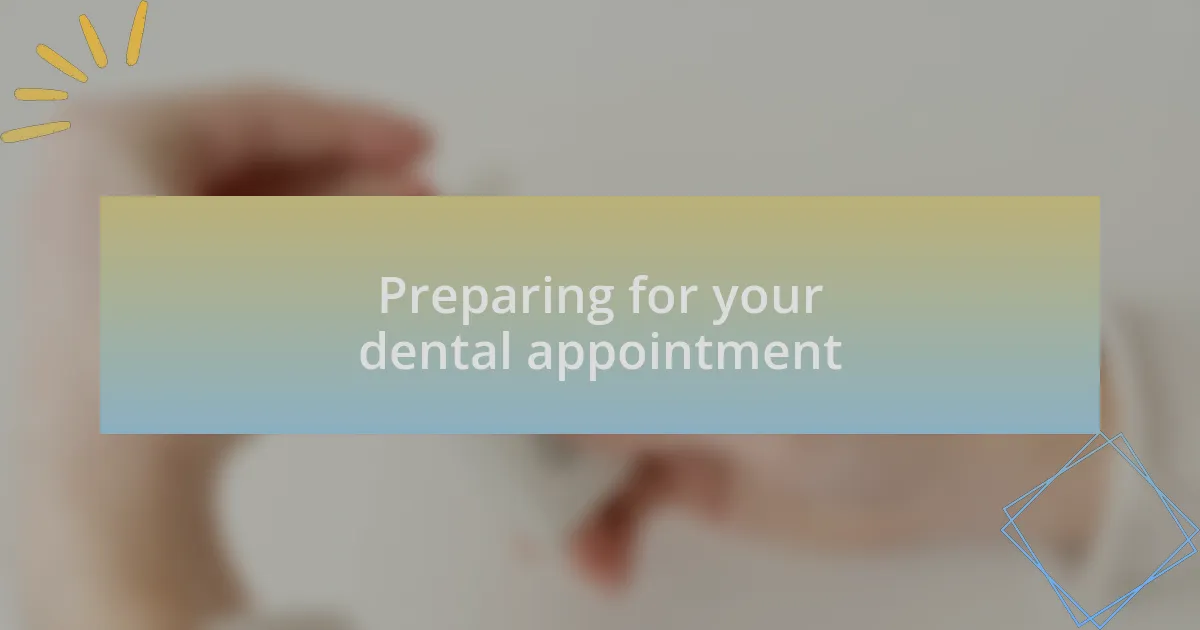
Preparing for your dental appointment
As you get ready for your dental appointment, it can be helpful to write down any questions or concerns you may have. I once had a patient who came in with a list in hand. While at first, it seemed overwhelming, it actually transformed our conversation into a focused dialogue. This preparation not only eased their anxiety but also ensured that we addressed what really mattered to them. Have you ever thought about how this simple step can turn an intimidating visit into a more collaborative experience?
Another tip is to familiarize yourself with the clinic’s environment before your visit. I remember guiding a young patient through our office before their actual appointment. Walking through the space, getting to know the staff, and understanding where everything is made them feel surprisingly at ease. We discussed what they could expect during the visit, and it made a world of difference. Wouldn’t you agree that knowing what to expect can ease anxiety?
Finally, consider practicing relaxation techniques before you arrive. Deep breathing or visualizing a peaceful place can shift your mindset significantly. I often recommend this to patients who struggle with nerves. In sharing my own experience of calming my mind before my own appointments, I found that these techniques can truly create a sense of control. Isn’t it amazing how a few moments of mindfulness can shift your perspective and prepare you for the day?
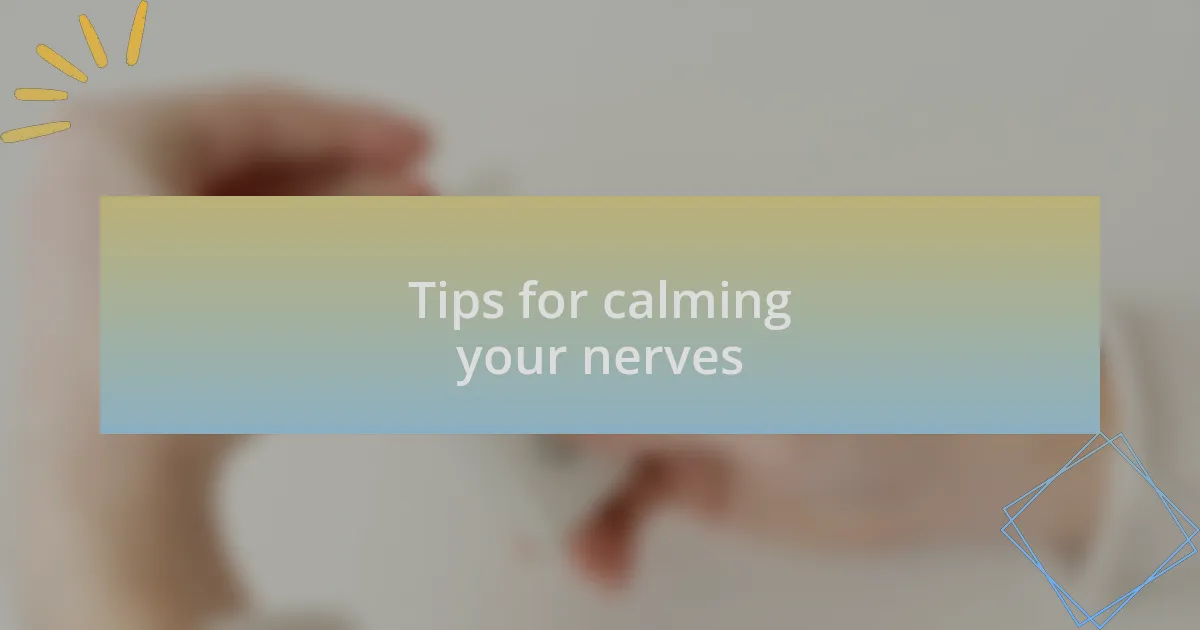
Tips for calming your nerves
When it comes to calming your nerves, one technique that has worked wonders for me and many patients is bringing a comforting object along. I once had a patient who brought their favorite stress ball. Just holding it during the appointment provided them with a sense of calm and helped alleviate their anxiety. Have you ever thought about how a simple item can act as a grounding force in a stressful situation?
Another effective method is to enlist a support system. I remember a time when a patient brought their partner along for extra support. The comforting presence of a loved one in the waiting room made all the difference; their presence allowed my patient to feel safe and secure. Don’t you think having someone who understands your fears can make the experience much more manageable?
Lastly, consider making a playlist of your favorite calming music to listen to just before your appointment. I’ve had patients who come in with their headphones already on, taking a few moments to immerse themselves in soothing sounds. I can attest to the powerful impact music has – it can transport you away from anxiety and create a more positive mindset. Have you ever noticed how a good song can change your mood entirely?
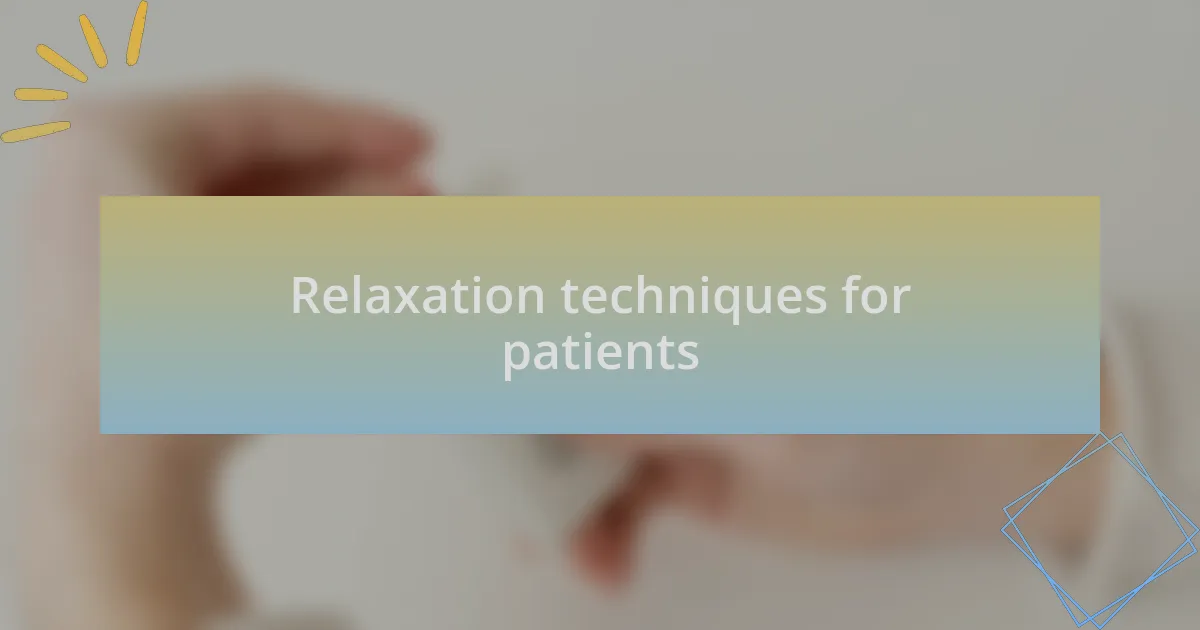
Relaxation techniques for patients
One relaxation technique that I find beneficial for many anxious patients is deep breathing exercises. I recall sitting with a patient who was visibly tense before their procedure. After guiding them through a series of slow, deep breaths, I saw their shoulders drop and their expression soften. Have you ever noticed how just a few deep breaths can ground you in the moment, making everything feel just a bit more manageable?
Progressive muscle relaxation is another method I encourage. During a recent appointment, I instructed a patient to tense and then gradually relax different muscle groups, starting from their toes and working their way up. The transformation was remarkable; they emerged noticeably calmer and more at ease. Isn’t it fascinating how consciously releasing tension can lead to a profound sense of relief?
Visualization techniques also play a crucial role in relaxation. A patient once shared with me how picturing a serene beach landscape helped them cope with dental anxiety. As they closed their eyes and described the waves lapping at the shore, I could see their stress fade away. Have you ever tried visualizing a peaceful scene to escape from a stressful moment? The power of the mind can be an incredible ally in managing anxiety.
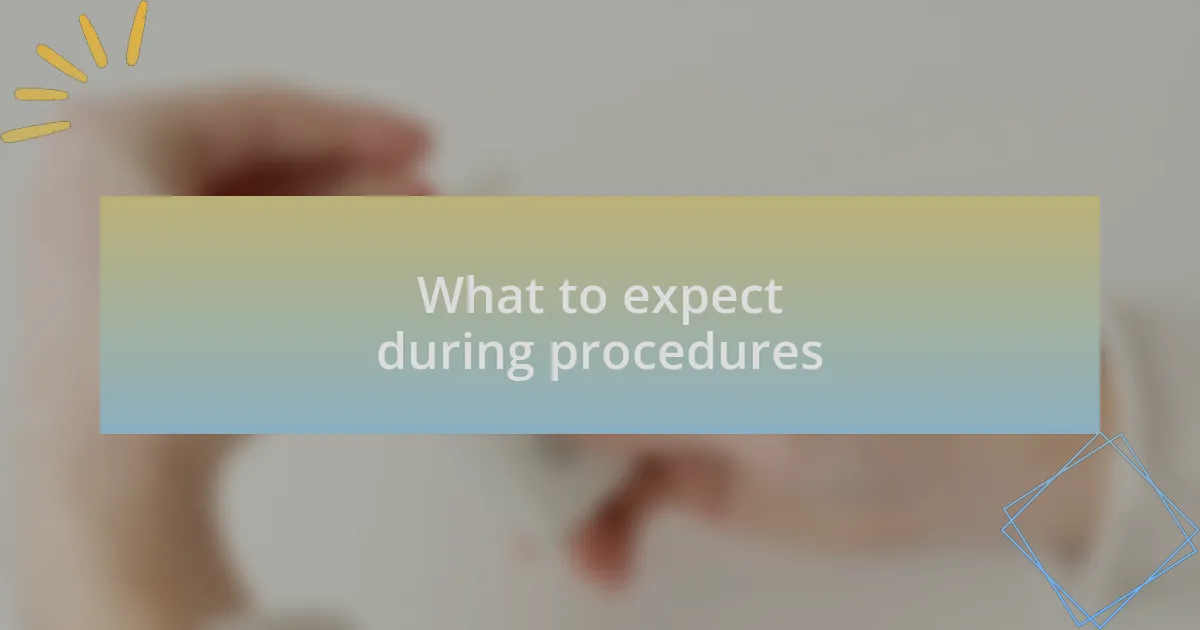
What to expect during procedures
During procedures, many patients feel a rush of anticipation, and it’s important to know what to expect. I remember one particularly nervous patient who expressed concern about the sounds of the dental tools. I reassured them that the sounds are normal and part of the process. Understanding that these noises are simply the sounds of care can often help shift the focus from fear to reassurance.
Patients can also expect a clear explanation of each step as the procedure unfolds. In a recent appointment, after explaining what the patient would feel and hear during the treatment, they told me they felt more in control. Isn’t it interesting how knowledge can transform anxiety into a sense of participation?
Finally, the atmosphere of the clinic plays a significant role in your experience. I’ve seen how a warm smile from the dental team can instantly put a patient at ease. When you know there’s a friendly face ready to support you, it can make a world of difference. How does it feel to know that your comfort is the priority during your time in the chair?